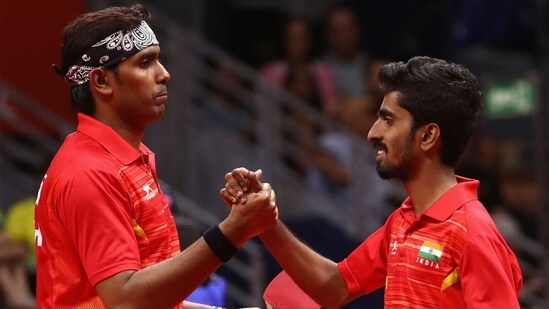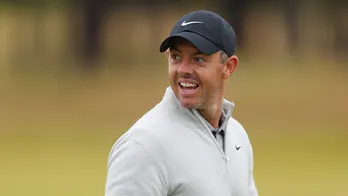Sharath-Sathiyan: A healthy table tennis rivalry, a special personal bond
Months after he beat Sharath Kamal for the first time in the senior national table tennis championships in 2015, G Sathiyan was hunting for clubs in Europe to train. Helping him in that search was Sharath, who approached a top division German Bundesliga club for his younger compatriot.  PREMIUM
PREMIUM
“He (Sharath) told them, ‘Sathiyan actually beat me’,” Sathiyan recalls. “That’s how he introduced me - the nice person that he is. The club soon gave me a training spot.” Two years later, Sathiyan went on to play for the same club, ASV Grunwettersbach Tischtennis.
That’s the country's top two paddlers for you: fierce competitors taking Indian table tennis to unchartered territories, individually and collectively; healthy rivals pushing each other to higher peaks and friends off the table with great mutual respect.
The Chennai men have a 10-year age gap, but their tussle refuses to fade away. Sharath, two months shy of turning 40, beat the 29-year-old Sathiyan in seven games in the final in Shillong last week for his 10th singles national title. It was the fifth time in seven years that they have battled in the nationals. The first time they did, a rising Sathiyan breezed past Sharath 4-0 in the 2015 semi-finals in Hyderabad. The senior player though won the next two meetings, 4-2 in Ranchi in 2017 and 4-3 in the 2018 final in Cuttack. Sathiyan got his second win - and a first senior national title - when he defeated his fellow Petroleum Sports Promotion Board (PSPB) teammate in a six-game title clash last year.
“It shows how strong we both are,” Sharath says. “It also justifies our international ranking - we’re pretty close, around the 30s. It’s good to have someone around who keeps pushing you, stretching your limit. It’s very healthy that way.”
Sathiyan says: “It has been a healthy rivalry, it’s fantastic that Sharath is still inspiring youngsters. It’s both ways - the youngsters are also pushing him to be at that level. It’s always been tough competition when we play each other. That’s the quality we bring in.”
A big reason for that - except the 2015 match, all their nationals encounters have been close - is their contrasting playing styles. Sathiyan describes it as a classic speed versus power duel. “He’s a far more powerful player with a super aggressive game and one of the best forehands in the world. His game is more on power and strength while mine is built more on placement, counter-attacks and quick speed,” he says.
Sathiyan’s rise, Sharath’s rejuvenation
Sathiyan’s rise at national and world level over the last few years has coincided with Sharath’s rejuvenation in the winter of his career. Ever since the former first overtook his senior in the singles ITTF world rankings in 2018 and achieved the highest spot by an Indian (24) the following year, there’s been a frequent exchange of the tag as India’s top-ranked player between them.
“There has always been decent competition within the country; there was only a brief period where I was dominating the domestic scene,” Sharath says. “But soon this younger batch came up, and since then the competition and intensity is beyond comparison. Because we’ve never had two top-50 players in the country, and both constantly playing in the domestic circuit.”
Sharath is world No 38 with Sathiyan a spot below him. Neither is fussed who is ranked above as long as they are taking Indian tennis forward. “It’s not just pushing each other, but the entire Indian flock,” Sathiyan says. “If there’s one guy doing it, it’s an aura. When another person does it, it turns into belief for the fraternity that ‘I can also do it’. The world ranking has been cat and mouse for us. It has set a high benchmark.”
Their camaraderie hasn’t been affected by the generation gap. “Sometimes we forget he is almost 40,” Sathiyan smiles. “He is so senior, but talks to us as a younger guy. He has always been friendly and gives you that freedom to go up and talk to him. There’s good friendship and respect between us.”
At the peak of Covid-19 in 2020, the two joined hands to financially support those in Indian table tennis impacted by the pandemic. They often get together to plan training gigs and tournament schedules for the national team. The latest occasion was after the gruelling final in Shillong.
“We spoke intensely for a very long time at the prize distribution ceremony, a lot of people wondered what it was about. We were discussing India’s preparation for the Commonwealth Games (CWG) and Asian Games, seeing which period we can train as a team, where can we go for it,” Sharath says.
Their personal equation, and the endeavour to keep raising their games, reflects in the returns for Indian table tennis from multi-nation events in the last few years. At the 2018 CWG, the men's team won gold and the Sharath-Sathiyan pair silver in doubles. The men’s team also won a historic first TT medal for the country at the 2018 Asian Games.
“As a team it’s important to gel and give that confidence to the rest of the boys. Only when the top two players do that, the team builds,” Sathiyan says. “And because we play against each other so much, we know our strengths and weaknesses. We share a lot of data and pull each other up during moments of doubt. That can only come when there’s trust and belief in one another and in their game and capabilities.”
Sharath says: “When Sathiyan was younger, I used to help him. But in recent times, he has been helping me, saying ‘c’mon anna, play this tournament, go for this’. I’m a little bit lost with the change in the system, structure and rankings. So, many times I’ve listened to him, played a tournament and done well.”
From 2015 to 2022, little has changed between Sharath and Sathiyan, be it as competitors or well-wishers.
Experience unrestricted digital access with HT Premium
Explore amazing offers on HT + Economist Start 14 Days Free Trial Already Subscribed? Sign In
Disclaimer: The copyright of this article belongs to the original author. Reposting this article is solely for the purpose of information dissemination and does not constitute any investment advice. If there is any infringement, please contact us immediately. We will make corrections or deletions as necessary. Thank you.







